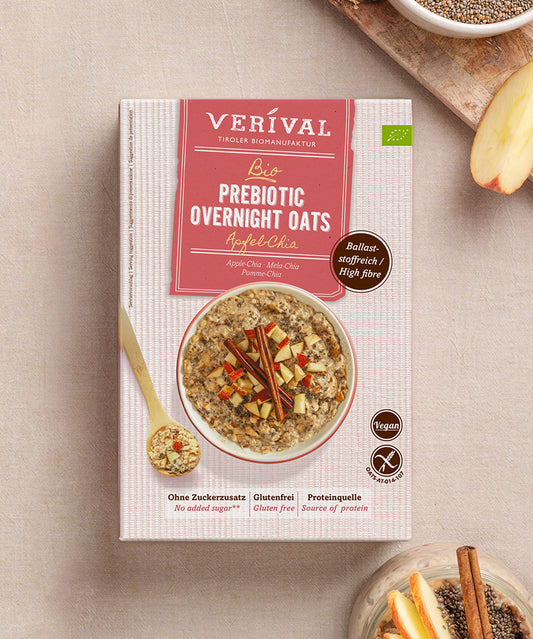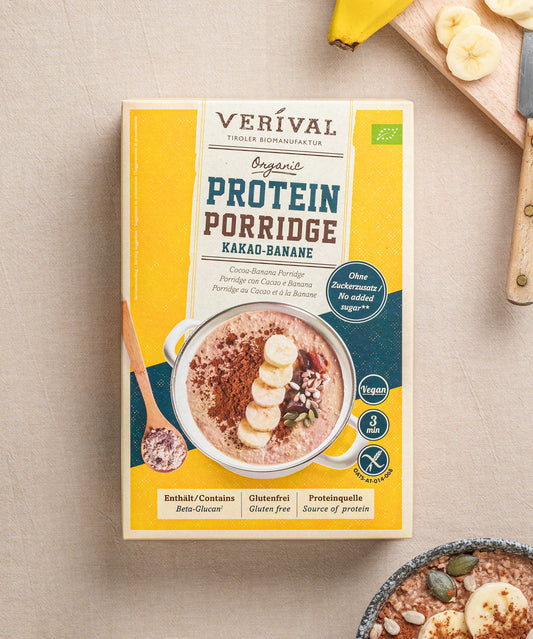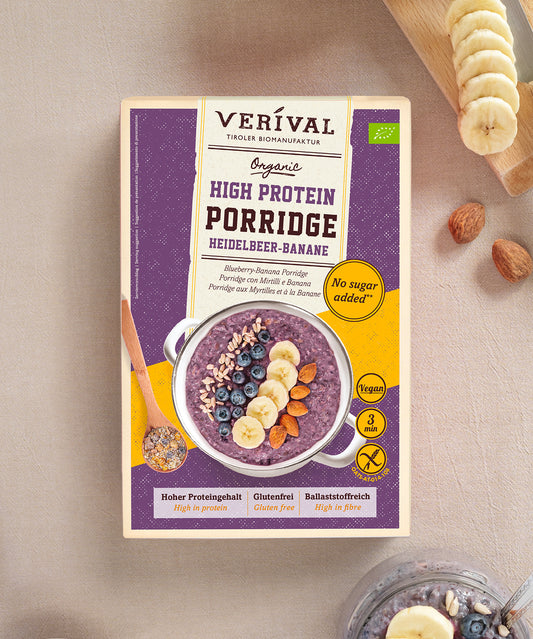Vegetable and animal fats have been part of the human diet for a long time. Here you can learn more about fats in general, but above all you can learn more about nuts and omega-6 foods.
Nuts are often labelled as fattening and calorie bombs. This is mainly because nuts contain a relatively high amount of fat, namely between 50g and 75g of fat per 100g on average. However, not all fats are the same.
There are different types of fatty acids and these all have different effects on our body. In this article, we will explain which fatty acids are found in nuts and why nuts are particularly high in healthy fats.
Healthy nuts from Verival – discover them here
There are two types of fatty acids: saturated fatty acids and unsaturated fatty acids.
A fundamental distinction is made between two types of fatty acids: saturated and unsaturated fatty acids. Saturated fatty acids are unhealthy fatty acids that do not have any double bonds in the fatty acid chain. Saturated fatty acids are found in all animal products and foods, such as butter, dairy products, meat and sausage. In contrast, unsaturated fatty acids (also found in vegetable oils, for example) are healthy for the body because they contain double bonds between the carbon atoms.
When it comes to unsaturated fatty acids, we can then in turn distinguish between mono- and polyunsaturated fatty acids. In the case of monounsaturated fatty acids, the molecule has one double bond in the fatty acid chain, while in the case of polyunsaturated fatty acids, there are two or more double bonds.
What role do these fatty acids play in nutrition?
In principle, fatty acids should be an essential part of your daily diet. Fat is responsible, among other things, for the hormones in our body and is part of our body structure, for example in cell membranes. Fat therefore plays a very important role in our body and should therefore be consumed in sufficient quantities.
The German Nutrition Society (DGE) recommends that, for a healthy diet, an adult with light to moderate physical activity should consume a maximum of 30% of their total daily energy intake in the form of fat. According to the recommendation, a maximum of 10% saturated fats, 13% monounsaturated fatty acids and 7% polyunsaturated fatty acids should be ingested with the daily food intake.
Saturated fatty acids increase our blood lipids such as triglycerides, the so-called ‘bad’ LDL cholesterol and consequently the total cholesterol.
Attention: solid vegetable fats such as coconut oil or palm oil also contain saturated fatty acids. So there are really good fats and bad fats.
These fatty acids are found in nuts – nuts and omega 3
Nuts are particularly high in high-quality fat. They contain a small amount of unhealthy saturated fatty acids and a high proportion of healthy unsaturated fatty acids. Nuts, and in particular walnuts, are known for their high proportion of the polyunsaturated fatty acid omega-3.
This is why the fatty acid omega-3 in nuts is so healthy
In terms of fat distribution, walnuts are an excellent choice. They contain mainly polyunsaturated fatty acids and also have an optimal omega-6 to omega-3 fatty acid ratio. The ratio of omega-6 to omega-3 intake should be around 5:1. This means that you should consume 5 parts omega-6 fatty acids to 1 part omega-3 fatty acids.
The ratio of omega-6 (linoleic acid) to omega-3 (alpha-linolenic acid) in nuts
This ratio between the two fatty acids is very important. The messenger substances from omega-6 fatty acids have an inflammatory effect, while omega-3 fatty acids have an anti-inflammatory effect. If we consume too much omega-6 fatty acids (e.g. sunflower oil, safflower oil), the effect of omega-3 fatty acids (e.g. contained in olive oil, canola oil and fish oil) is blocked.
In reality, however, the ratio of omega-6 to omega-3 in many people is 20:1. In practice, this means that you should increase the proportion of omega-3 fatty acids in your diet, for example by eating walnuts, rapeseed oil and linseed oil.
But other nuts, such as the macadamia, also have an almost optimal omega-6 to omega-3 fat ratio of 6:1. They also contain a lot of monounsaturated fats and only a small amount of polyunsaturated fats.
Why is the fat in nuts so healthy?
As already mentioned, nuts such as cashews, almonds, walnuts and hazelnuts contain a particularly high proportion of monounsaturated and polyunsaturated fatty acids. Some nuts, such as walnuts and macadamias, have a particularly good ratio of omega-3 and omega-6 fatty acids, while other nuts, such as peanuts, contain fewer omega-3 fatty acids but more protein.
Overall, all nuts have a positive effect on blood lipid levels (cholesterol levels) due to the omega-3 they contain, as well as helping to prevent diabetes and cardiovascular diseases. Due to the multitude of health benefits of eating nuts, they should definitely not be missing from your diet. Whether as a snack, stirred into your porridge or as an ingredient in baking, a handful of nuts can be easily integrated into your diet and the vegetable fats are good for your body.
The macadamia – the queen of nuts
The macadamia nut (also known as the Queensland nut) originated in the rainforests of Australia. Today, however, Hawaii, South Africa, New Zealand, Kenya, Brazil and California are also important growing areas. Named after the Scottish-Australian scientist John Macadam, the macadamia nut is now one of the finest types of nut.
These nuts, which are incidentally the most expensive in the world, are characterised by their hard shell and soft kernel. The macadamia tree (Macadamia integrifolia) often forms several stems and belongs to the silver tree family. In early summer, the white, sometimes pink or lilac flowers hang down in long inflorescences.
The trees produce their first fruits between the ages of seven and ten years. The fruits of the macadamia ripen – if harvested regularly – several times a year in a hard shell and fall to the ground as soon as they are ripe. Since macadamias are difficult or impossible to open with a conventional nutcracker, they are usually sold shelled.
The original inhabitants of Australia - the Aborigines - found the kernels edible and appreciated macadamias as a source of nutrition.
To the organic porridges from Verival
Why are macadamia nuts so healthy?
With a fat content of 75%, the macadamia nut is one of the nuts with the highest fat content. But these are valuable fats that do not harm the body. Macadamia nuts are also true nutrient bombs in terms of the proportion of essential nutrients, which support the body in numerous important functions even in small quantities. They contain numerous vitamins (such as vitamin b, vitamin b1 and vitamin E). They are rich in unsaturated fatty acids such as omega-3.
What are the health benefits of macadamias?
- They support your digestion
- Strengthen your cardiovascular system
- Prevent the aging process
- Strengthen your muscles and nerves
- Support brain function and strengthen your bones
- Help you lose weight
Whether you enjoy the nuts on their own or whether you want to roast them and add them to your Verival muesli or porridge is entirely up to you.
In addition to macadamia nuts, cashews and pecans are also valuable sources of energy and nutrients – and a little cheaper in shops.
Our nuts conclusion
Nuts are a high-quality source of healthy fatty acids because they mainly contain monounsaturated or polyunsaturated fatty acids and many nuts also have a good ratio of omega-6 fatty acids to omega-3 fatty acids. Nuts should definitely be part of your daily shopping basket.
The valuable omega-3 in nuts is one thing, but they also contain high-quality protein, healthy fibre and micronutrients such as vitamins and minerals. Since they are a purely plant-based food, they are also perfect for a vegan diet. Find out what other nutritional values are contained in different types of nuts such as cashews, almonds, walnuts, etc. here.
Incidentally, there are also so-called trans fatty acids. Trans fats are unsaturated fatty acids that are formed during various processes such as frying. They are therefore found in many baked goods. They should be avoided if possible.
If you want to protect your body from heart disease and maintain important functions in the human body for a long time, then you should avoid processed products as much as possible. Here are a few examples of omega-3 and omega-6 foods that are rich in healthy fats: tuna, avocados, flaxseed, mackerel, nuts, etc.
And there are differences between vegetable oils too. Walnut oil, rapeseed oil and olive oil should always be on your menu.
Frequently asked questions
How healthy are macadamia nuts?
In terms of essential nutrients, macadamia nuts are true nutritional powerhouses, supporting the body in numerous important functions even in small quantities. They contain many vitamins (such as vitamin B, vitamin B1 and vitamin E) and are rich in unsaturated fatty acids such as omega-3. This helps to support your digestion, strengthen your cardiovascular system, prevent the aging process, strengthen your muscles and nerves, support brain function and strengthen your bones. They also help you lose weight by keeping you feeling full for longer.
How many macadamia nuts a day?
The special thing about macadamia nuts is that even a small amount gives your body a concentrated supply of essential fatty acids, vitamins and fibre, but of course also calories. That's why 10 nuts a day are enough to provide you with plenty of nutrients.
Why are macadamia nuts so expensive?
The extremely protein- and fat-rich nut is comparatively very expensive because its cultivation and, above all, its processing are costly. Also, the demand for this fine nut is constantly growing and supply does not always keep pace with the growing demand.
Can you eat too many macadamia nuts?
Macadamias are very high in fat and therefore contain a lot of calories. Of course, if you eat too many macadamia nuts, the high calorie content can have a negative effect. You should therefore not eat more than 10 nuts a day. You should also be careful not to eat salted nuts, which are often available in shops.
























